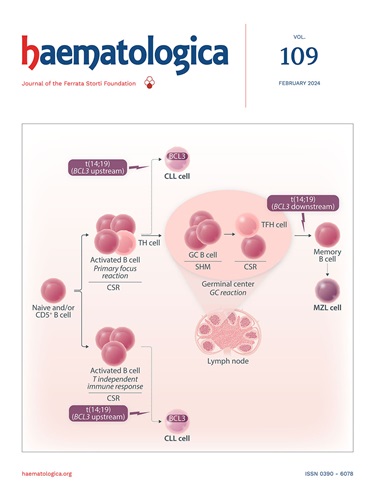MHC disparity hampers thymus-dependent T-cell recovery post-hematopoietic transplantation through dysregulation of TGF-β1 and LRP6 pathways.
IF 7.9
1区 医学
Q1 HEMATOLOGY
引用次数: 0
Abstract
Clinical studies have demonstrated that recipients of allogeneic hematopoietic cell transplantation (alloHCT), particularly those undergoing HLA-haploidentical alloHCT (haploHCT), exhibit significant immune deficiencies. However, the extent to which major histocompatibility complex (MHC) disparity independently contributes to the observed lymphocyte deficiency post-alloHCT remains unclear. While MHC matching is crucial for thymic selection of T lymphocytes, it has yet to be reported whether haploHCT alters recipient thymus homeostasis compared to MHC-matched HCT and which signaling pathways are implicated in this alteration. In this study, we established mouse models of MHC- matched and haploidentical HCT without any transplant-associated complications. Our findings indicated that MHC disparity significantly disrupted thymic architecture, suppressed thymus-specific gene expression, and resulted in impaired T-cell recovery and functionality following transplantation. Single-cell transcriptomic analysis revealed abnormally enhanced interactions involving TGFB1-TGFBR3 and LRP6-CKLF between thymic lymphocytes and epithelial cells in haploHCT recipients. Furthermore, agonists targeting the TGF-β1 and LRP6 pathways were found to compromise the functional characteristics of normal thymic T cells; conversely, appropriate inhibition of these pathways restored the differentiation and maturation phenotypes of thymic T cells derived from haploHCT recipients. Our study elucidates the independent role of MHC disparity in regulating thymus homeostasis and T-cell recovery while identifying the functional involvement of the TGF-β1 and LRP6 pathways in this context. These findings provide novel insights into the mechanisms underlying immune recovery as well as potential therapeutic strategies for modulating thymic functions following haploHCT.MHC差异通过TGF-β1和LRP6通路失调阻碍造血移植后胸腺依赖性t细胞恢复。
临床研究表明,接受同种异体造血细胞移植(allogeneic hematopoietic cell transplantation, alloHCT)的患者,特别是接受hla -单倍体同种异体造血细胞移植(haploHCT)的患者,表现出明显的免疫缺陷。然而,主要组织相容性复合体(MHC)差异在多大程度上独立促成了观察到的同种异体hct后淋巴细胞缺乏仍不清楚。虽然MHC匹配对T淋巴细胞的胸腺选择至关重要,但与MHC匹配的HCT相比,单倍HCT是否会改变受体胸腺稳态,以及哪些信号通路与这种改变有关,目前还没有报道。在这项研究中,我们建立了MHC匹配和单倍体相同的小鼠HCT模型,没有任何移植相关的并发症。我们的研究结果表明,MHC差异显著破坏胸腺结构,抑制胸腺特异性基因表达,导致移植后t细胞恢复和功能受损。单细胞转录组学分析显示,单倍hct受体胸腺淋巴细胞和上皮细胞之间涉及TGFB1-TGFBR3和LRP6-CKLF的相互作用异常增强。此外,发现靶向TGF-β1和LRP6通路的激动剂会损害正常胸腺T细胞的功能特征;相反,适当抑制这些途径可以恢复来自单倍hct受体的胸腺T细胞的分化和成熟表型。我们的研究阐明了MHC差异在调节胸腺稳态和t细胞恢复中的独立作用,同时确定了TGF-β1和LRP6通路在此背景下的功能参与。这些发现为单倍hct后的免疫恢复机制以及调节胸腺功能的潜在治疗策略提供了新的见解。
本文章由计算机程序翻译,如有差异,请以英文原文为准。
求助全文
约1分钟内获得全文
求助全文
来源期刊

Haematologica
医学-血液学
CiteScore
14.10
自引率
2.00%
发文量
349
审稿时长
3-6 weeks
期刊介绍:
Haematologica is a journal that publishes articles within the broad field of hematology. It reports on novel findings in basic, clinical, and translational research.
Scope:
The scope of the journal includes reporting novel research results that:
Have a significant impact on understanding normal hematology or the development of hematological diseases.
Are likely to bring important changes to the diagnosis or treatment of hematological diseases.
 求助内容:
求助内容: 应助结果提醒方式:
应助结果提醒方式:


